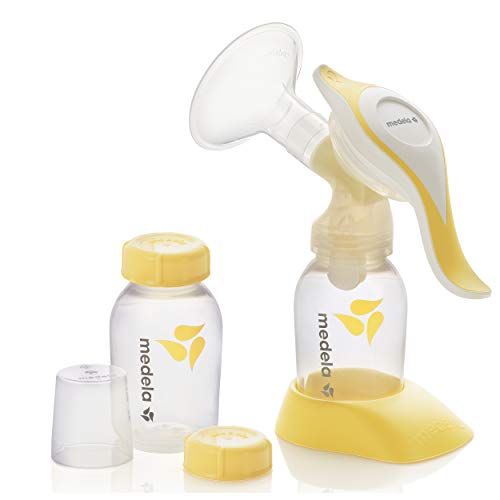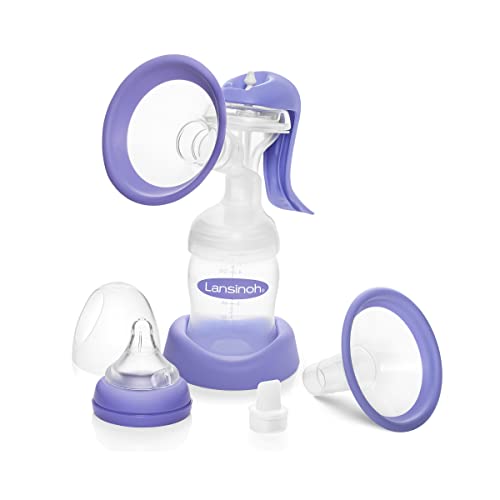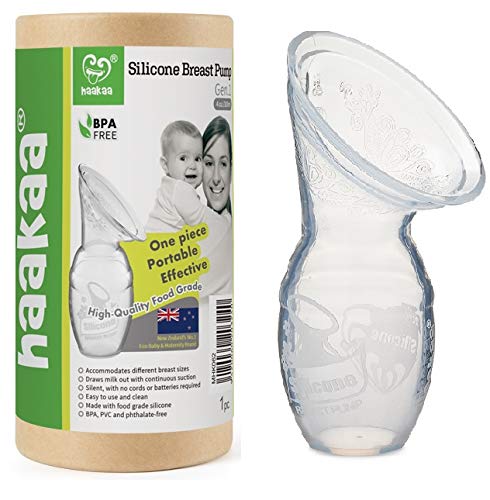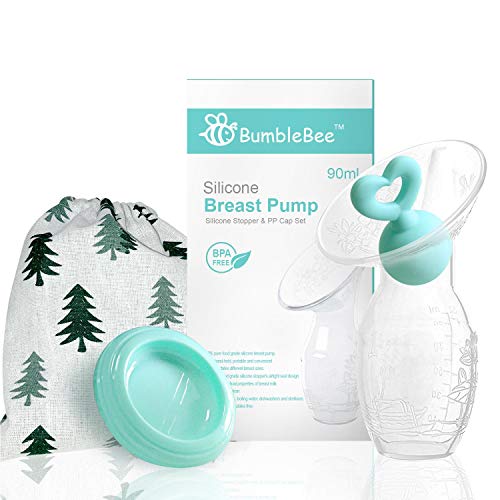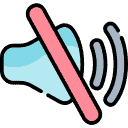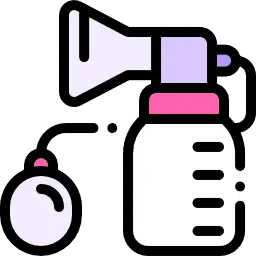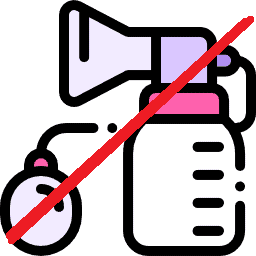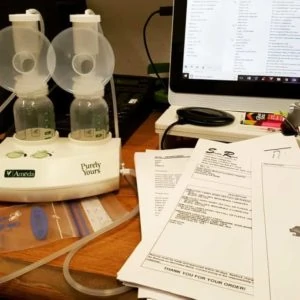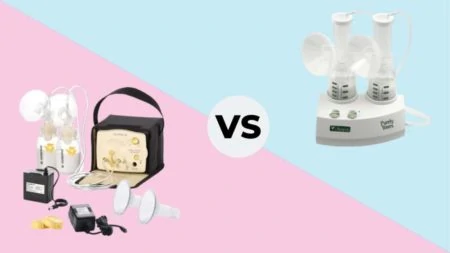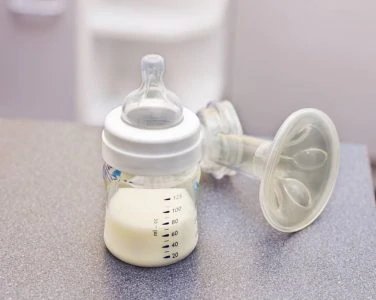Electric breast pumps make pumping a breeze — until you can’t find an outlet or run out of fresh batteries. That’s just one reason why we recommend a backup manual pump. Manual pumps also cost less and can be durable, as long as you choose a reliable product.
We’ve studied several trustworthy brands, considered customer reviews, and done the work of selecting the top five manual pumps on the market. You can rest assured that when you’re in a pickle, these five best manual breast pumps will have your back.

- Doesn’t make any noise
- Affordable
- Easy to setup, no hassle

- Lightweight and compact
- More affordable than other pumps
- Comfortable to hold

- Comfortable to use
- Easy to pump
- Expresses milk quickly

- Affordable
- Lightweight and very easy to clean
- Soft and comfortable

- Inexpensive
- Easy to clean, less stress
- Comfortable against breast
The Best Manual Breast Pumps of 2023
Here are 5 great manual breast pumps currently on the market.
Medela Harmony Manual Breast Pump
Best Manual Breast Pump for Low Milk Supply
The Medela Harmony includes the breast pump, a 24 mm breast shield, one 5-ounce bottle with a lid and a stand, and all the breast pump parts you’ll need.
It uses 2-phase expression technology.
During the first phase, you prepare your breasts for letdown, by using the lever that is closest to the breast shield. But once your milk begins to come out of your breast, you use the longer lever to pump the milk until your breast is emptied.
Moms may like that although the suction is great with this pump, it feels more gentle than some other manual breast pumps. Although this pump does come with instructions, you might not need them because it’s pretty easy to figure out.
Pros
- It doesn’t make any noise.
- Affordable.
- Easy to put together and compact enough for a large purse.
Cons
- The suction power seems to lessen after repeated use.
- Some users have reported the o-ring on the pump breaking easily, which could mean you may end up needing a replacement piece.
Our Ratings
Lansinoh Manual Breast Pump
Best Manual Breast Pump for Working Moms
This pump uses two different modes – a stimulation mode and an expression mode. It has breast shields that fit two sizes, both standard and large, which will help moms find the right suction and a fit that will work for them.
Its ergonomic design and the easy-express handle will stop your hand from getting pins-and-needles from all those repetitive movements. The pump can be used with Lansinoh’s Momma bottle and their milk storage bottles.
The wide-neck bottle attached to the pump makes it a cinch to transfer the contents into a breast milk storage bag.
Taking this bottle apart to clean it only takes a minute or two. After an easy cleaning process and after the pieces have airdried, putting the bottle back together again just takes a moment.
Pros
- Lightweight and easy to travel with.
- More affordable than other pumps.
- Comfortable to hold.
Cons
- The suction isn’t as great as some manual pumps.
- Not compatible with some bottles.
Our Ratings
Philips Avent Manual Comfort Breast Pump
Best Manual Breast Pump for Everyday Use
You should be able to use this pump without fear of killer hand cramps because of its unique design, which helps moms find a comfortable pumping position.
It has a textured massage cushion that is supposed to help with letdown to start a woman’s milk flow. The pump is lightweight, and its compact design makes it perfect for traveling. You can easily fit this unit into an oversized purse.
Finding a good position on your breast with this pump is an easy feat, and it’s also simple to continue to hold it in place while you pump.
Moms who have Philips Avent Natural and Classic bottles will be pleased to know they’re compatible with this breast pump. But moms who have standard size bottles may want to look at other breast pumps because this one only fits wider-mouthed bottles. The pump pieces are easy to clean, and they can be placed in the top rack of the dishwasher.
Pros
- Comfortable to use.
- Easy to pump.
- Expresses milk quickly.
Cons
- It can be a little squeaky during use.
- It doesn’t fit standard size baby bottles.
Our Ratings
Haakaa Silicone Manual Breast Pump
Best Breastmilk Catcher
The Haakaa breast pump has a bit of a cult following and for a good reason. Its iconic design couldn’t be simpler, with a single piece of perfectly shaped silicone that you use to suction your breasts manually.
Fold the flange back, place it over your breast then release the flange back again to create a super stronghold. The Haakaa is best used as a milk catcher rather than relied on as a pump. Wear it while you breastfeed on one side, and it will take advantage of the letdown on the other, scoring you a few more ounces of milk without actively pumping it.
Some moms have been able to pump by squeezing and releasing. Others find it’s better as an occasional relief only and still use a stronger pump at other times.
Pros
- Affordable.
- Lightweight and very easy to clean.
- Soft and comfortable against your breast.
Cons
- This model is almost certainly not strong enough to actively pump much milk.
- Might not suck as well after repeated use.
- Some moms have complained that the measurements are not accurate.
Our Ratings
BumbleBee Manual Breast Pump
Best Manual Pump for Large Breasts
This pump, made for occasional use, costs a lot less than many of its competitors. Moms can simply attach the pump and let it draw the milk through suction, and the milk pumps straight into a 90 mL capacity silicone holder.
BumbleBee manual pump allows moms to do all their pumping one-handed so they can accomplish other tasks at the same time. The pump only weighs 0.16 ounces, which feels like nothing in your purse. Plus there are very few parts to this pump, which makes it easy to assemble and clean, and it comes with a comfy silicone breast cushion.
It has an ergonomic spout that helps reduce the spills when transferring the collected liquid gold into the milk bags. Moms will find this pump works best when they lean slightly forward – that allows the milk to go into the bottle and not run out of the unit.
Pros
- Inexpensive.
- Easy to clean.
- Easy to assemble.
- Soft and comfortable against your breast.
Cons
- About 20 mL discrepancy of graduation noted in the cylindrical silicone.
Our Ratings
Who Should Choose a Manual Pump?
There are many differences between manual and electric breast pumps. Moms who want to pump multiple times a day may want to consider electric breast pumps, but if you’re just looking to pump occasionally, like once a day or less, a manual pump is the way to go (1).
Advantages of Manual Pumps
Disadvantages of Manual Pumps
Types of Manual Breast Pumps
Unlike their electric counterparts, manual pumps are pretty simple and intuitive to use. There are two basic types:
Levered Pumps
These consist of a nipple shield attached to a valve that opens into a bottle, making them look a little like air horns. This is a common design that allows moms to pump the lever and create suction against the breast to draw the milk out. Some models have levers that go two ways: a small pump is used in the beginning to massage and encourages letdown, a larger pump is used once milk flow begins.
Some models come with a cushioned part that goes between the cup and your breast, and some can be used with just one hand.
Silicone Models or “Milk Catchers”
These are also more passive milk catchers which consist of a single piece of shaped, food-grade silicone that fits around your nipple. There are two ways to use these: you could either fit the pump on one breast to catch any leaks while you breastfeed on the other, or you could manually squeeze the reservoir to create suction and pump milk.
You can usually purchase a cap or stopper to seal off your milk, which can amount to a few ounces even without any active pumping on your part.
How to Choose a Manual Breast Pump
How to Use a Manual Breast Pump
Using a manual pump is easy, even for those slightly squeamish moms who haven’t pumped milk before.
There are just a few steps to get started:
- Wash your hands to make sure you aren’t contaminating the storage bottle or any of the pump parts that will come in contact with your breast milk.
- Put the breast shield over your nipple. Your nipple should be centered and not touching the sides of the shield.
- Start pumping by squeezing the handle of your manual pump. You’ll need to do a few pumps before you see any milk coming out.
- When you are done pumping one breast for around 5 minutes, pump the other one. You don’t want your milk supply to dry up because you continuously favor one breast over the other.
- Once you’re done and have either fed your baby or stored the milk, wash the pump and let the pieces air dry until the next time you need them.
Manual Breast Pump FAQs
The Bottom Line
Manual breast pumps are a great option for women who occasionally pump, especially for moms who only pump once a day at their workplace or while traveling. Although manual pumping does require a bit of a learning curve, once you get the hang of it, you’ll find it becomes second nature.
So in the beginning, even if it feels a bit awkward, stick with it. You’ll catch on sooner than you think. While you may have a few good reasons to want to give up your pumping efforts, you have the best reason of all to keep trying – your baby.

